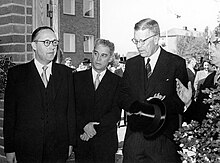Fysicum
| Fysiska institutionen vid Lunds Universitet | |

Sten von Friesen, Torsten Gustafson and king Gustaf VI Adolf of Sweden at the inauguration of Fysicum in 1951.
|
|
| Established | ~1735 |
|---|---|
| Head of Department | Knut Deppert |
| Location |
Lund, Scania, Sweden 55°42′36″N 13°12′14″E / 55.71000°N 13.20389°ECoordinates: 55°42′36″N 13°12′14″E / 55.71000°N 13.20389°E |
| Website | www |
The Department of Physics in Lund is a cooperative organization for nearly 300 scientists, educators and technical and administrative personnel, shared by both the faculty of science and the faculty of engineering at Lund University. The main goals are to expand the understanding of physics, its applications and to share scientific progress to new generations. The department also teaches fundamental physics to over one thousand students each year. Beside offering courses and a master's programme in pure physics, it also provides physics education for the engineering programmes.
In 1666 when Lund University was founded the physics research was conducted under the faculty of philosophy. Kilian Stobæus was appointed the first professorship in experimental physics 1728, but a pure department of science was not established until the late 19th century. Today the department is located in Fysicum, a building complex with its oldest parts built in 1950.
Scientists with activity at the department:
At the Department of Physics advanced research takes place divided in different divisions. The research areas are: Atomic Physics, Combustion Physics, Mathematical Physics, Nuclear Physics, Particle Physics, Solid State Physics and Synchrotron Radiation Research.
The department also hosts the Lund Nano Lab (LNL), part of NanoLund (formerly known as the Nanometer Structure Consortium), an interdisciplinary research enivronment for nanoscience and its applications in electronics, the life sciences etc. Further research centers are Lund Laser Centre (LLC), Consortium for Aerosol Science and Technology (CAST) and Lund University Combustion Centre (LUCC).
...
Wikipedia
